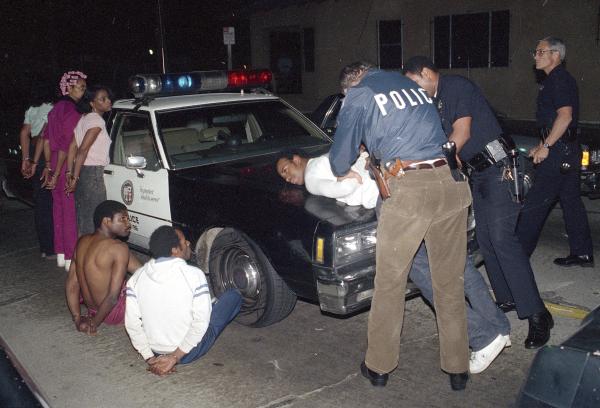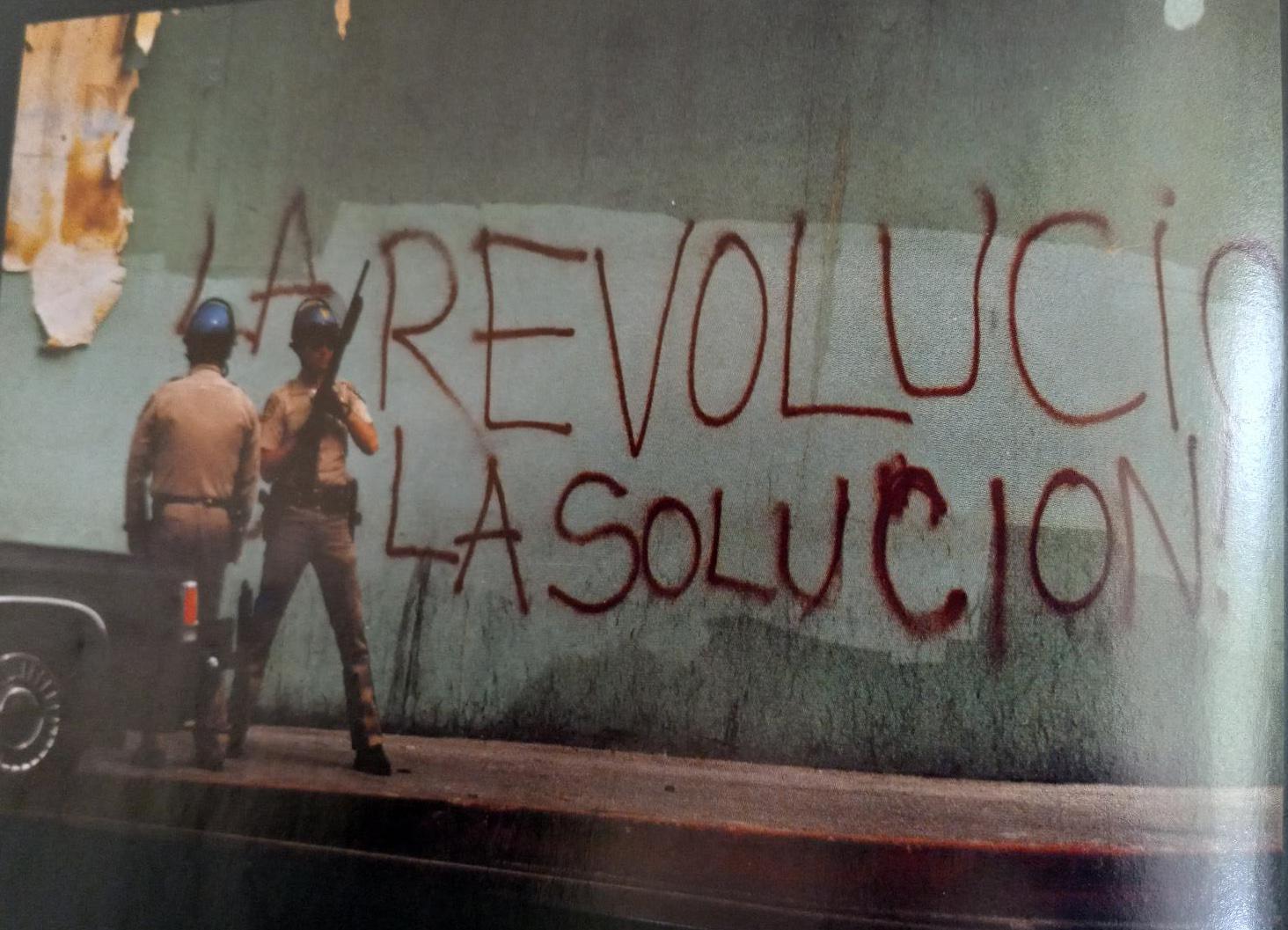
"The Revolution is the Solution." Screen grab of photo by Jim Mendenhall
Thirty years ago, April 29, 1992, the city of Los Angeles, the second largest city in the country, erupted in rebellion. Black people, joined by Latinos and people of many nationalities and coming from many different backgrounds, poured into the streets and refused to silently accept the unjust verdict which had just been rendered in the trial of the cops who brutalized a Black man, Rodney King. To mark this anniversary, we present a picture story of the LA Rebellion.
As a backdrop to the rebellion, here is an excerpt from Bob Avakian’s New Year’s Statement of 2021, A New Year, The Urgent Need For A Radically New World—For The Emancipation of All Humanity:
Since the end of World War 2 (75 years ago), the situation of Black people has dramatically changed…. Over the past several decades, due to heightened globalization and automation of production, interacting with continuing discrimination, there has been the elimination of a great deal of factory employment which provided Black men (and some women) with better-paying jobs in the urban areas. At the same time, as a result of the civil rights and Black liberation struggles of the 1960s/early ’70s, and other factors, there has been the growth of the Black middle class. But there has also been an increase of the so-called “underclass,” concentrated and contained in urban ghettos and more or less permanently locked out of regular employment in the “formal” economy.
Unable to provide a positive resolution to acute contradictions bound up with these changes—unable to end systemic racism which involves degrading discrimination against even economically better-off sections of Black people—unable to integrate large numbers of Black people into the “formal” economy—the ruling forces in society have responded to this situation with mass incarceration of millions of Black males (and growing numbers of females) with arrests, trials, convictions and sentences embodying yet more discrimination and injustice, and by unleashing and backing systematic police terror, which is especially directed against Black people in the inner cities but can target any Black person, anywhere, at any time. The attempt to brutally enforce “law and order,” given that a more just solution is impossible under this system, heightens the volatility of this whole situation, leading to further upheaval—including completely justified and righteous protest and rebellion….
Operation Hammer
In the late 1980s, the LAPD was in the vanguard of carrying out the “war on drugs,” which was actually a war on Black and other oppressed people aimed at ramping up suppression and social control. LAPD chief Daryl Gates declared that full manpower reserves of the LAPD would be thrown into super-sweeps called Operation HAMMER. In the first action of Operation HAMMER in April 1988, a thousand cops backed by elite tactical squads and a special “anti-gang” taskforce descended on 10 square miles of South Central Los Angeles and arrested more Black youth than at any time since the 1965 Watts Rebellion.
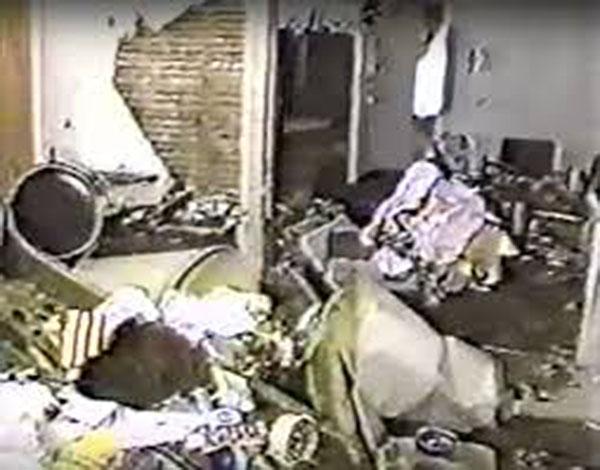
Dalton Street raid on August 1, 1988. (Video screen capture)
Dalton Street
One of the infamous operations during Operation HAMMER was the Dalton Street raid on August 1, 1988. Eighty-eight cops from the Southwest Division swooped down on a group of apartments on Dalton Avenue near Exposition Park. They wielded shotguns and sledgehammers and shouted racist slurs and insults.
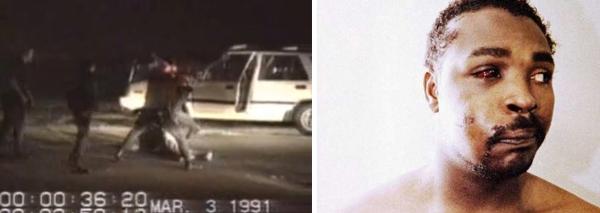
Rodney King being beaten by LAPD, and then after the beating.
Rodney King
The night of March 3, 1991, Rodney King, a young Black man, was pulled over for speeding. LAPD and Highway Patrol officers flooded to the scene and over the next few minutes, at least seven mercilessly beat and tased King, crushing the bones in his face, breaking his teeth and ankle, and causing numerous lacerations and internal injuries. Over a dozen other cops stood around laughing and encouraging the beating.
This kind of wanton terror and brutality by the pigs went on all the time—but the Rodney King beating was caught on video, and many people thought that this time, the offending cops had to be found guilty. A year later, four of the cops involved went on trial—in virtually all-white Simi Valley, where the trial had been moved to. On April 29, 1992, the Simi Valley jury verdict acquitting them of all charges was broadcast on live TV.
Rebellion sparked off at Florence and Normandie
Within minutes of the announcement of the acquittal of cops in the beating of Rodney King, people began gathering all over LA in outrage at the verdict. The gathering at Florence and Normandie in South Central became a flashpoint that propelled the whole rebellion.
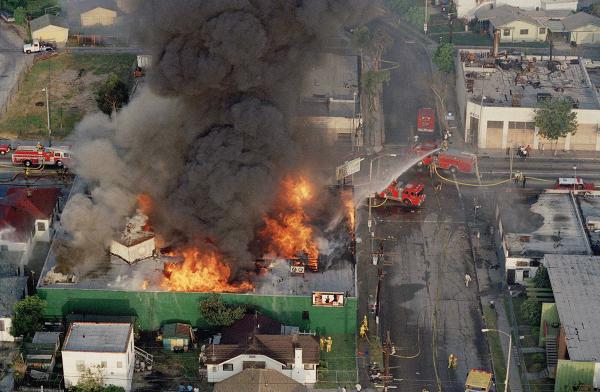
At Florence and Normandie in Los Angeles, protesting acquittal of cops who beat Rodney King. Photo: AP
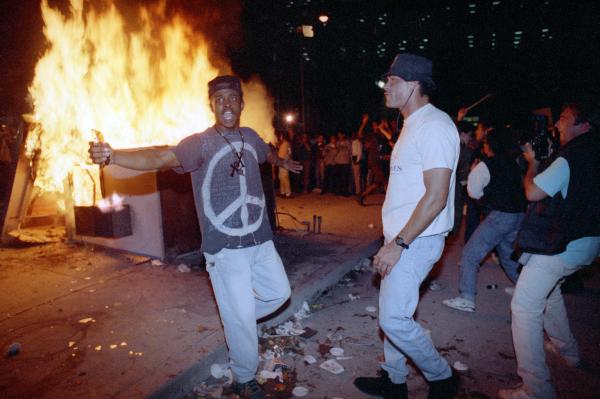
April 29, 1992, in front of Parker Center, youth protest the acquittal of the four LAPD cops who beat Rodney King. Photo: AP/Nick Ut
Parker Center—LAPD Headquarters
Another flashpoint was Parker Center, the headquarters of the LAPD. By that evening, fires were burning throughout LA and protests were jumping off across the country. Over the next three days, the authorities mobilized the largest domestic military operation since the 1960s, with nearly 20,000 police, National Guard troops, federal military troops, FBI, Border Patrol, and others on the streets. By the time it ended, the 1992 LA Rebellion had become the largest urban rebellion in U.S. history.
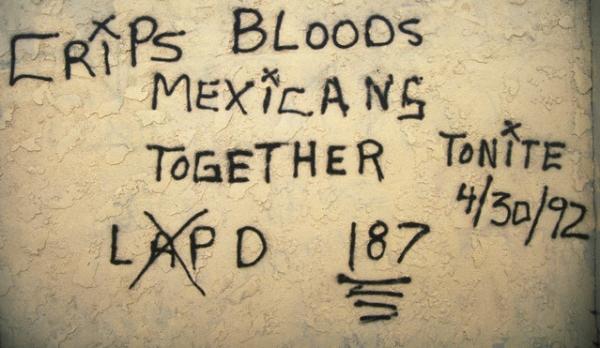
Gang Truce
Just before the rebellion erupted, a truce was worked out by warring gangs of Bloods and Crips. The truce suspended more than a decade of brutal and senseless fighting and killing among the people. A new situation was established and it gave strength to the rebellion, especially in Watts. For years the cops complained about “gang violence” and used it as justification to carry out wholesale attacks on Black and Latino youth. Now that the youth were beginning to overcome their differences and to think about fighting against their common oppression instead of each other, the authorities moved hard to shut the truce down. There were hundreds of unity meetings and parties in the weeks after the rebellion, and each one was attacked and broken up by the pigs.
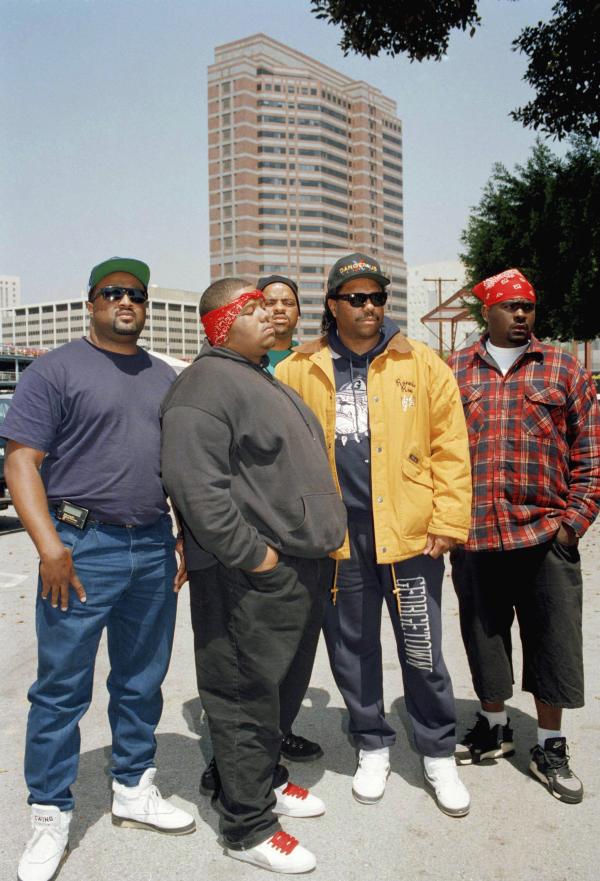
LA Gangs: Bloods and Crips together, after acquittal of cops who beat Rodney King. Photo: AP/Nick Ut
Revolutionary Communist Youth Brigade
Members of the Revolutionary Communist Youth Brigade were out in the streets among the people during the rebellion. And in the days and weeks afterwards, they were active in helping people sum up the rebellion and carry forward the struggle and prepare for revolution to overthrow the system.

Revolutionary Communist Youth Brigade Photo: Revolution
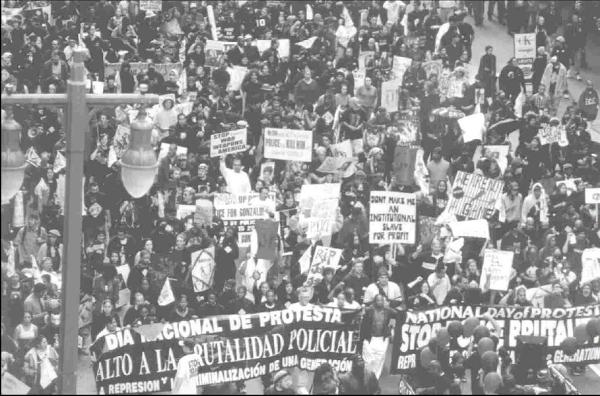
Los Angeles, October 22, 2002, National Day of Protest to Stop Police Brutality. Photo: Special to RW/OR
National Day of Protest to Stop Police Brutality, Repression, and the Criminalization of a Generation
In the 1990s, BA raised the idea that there should be a day, every year, when people mobilized to protest police brutality, mass incarceration and repression by the government. This proposal was taken up and a broad coalition, including family members of people killed by police, was formed to initiate, in 1996, the National Day of Protest to Stop Police Brutality, Repression, and the Criminalization of a Generation. At its height, over the next decade, this National Day of Protest, held every October 22nd, rallied thousands of people in dozens of cities across the country. And activities by people who have been part of this coalition have continued since then. (From “Bob Avakian for the Liberation of Black People and the Emancipation of All Humanity”)
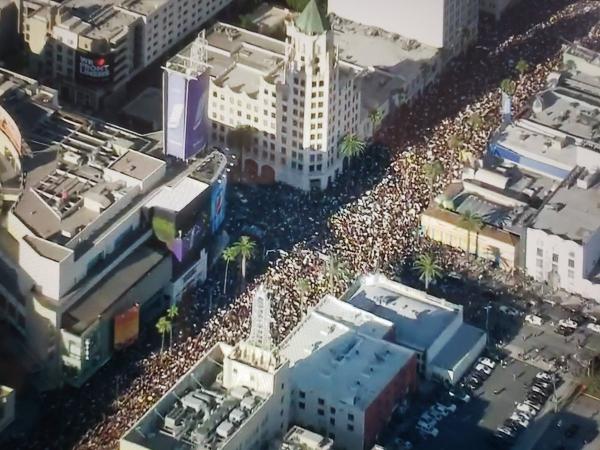
More than 20,000 gather in Hollywood to protest murder of George Floyd, June 2020. Photo: Youth Justice Coalition
George Floyd
As earth-shaking as the LA Rebellion was, the system of capitalism-imperialism that is at the root of the oppression of Black people and other oppressed people continues to exist, including police murdering people by the hundreds each year… and walking free time after time. In May 2020, a gang of Minnesota pigs squeezed the life out of George Floyd over nine agonizing minutes, ignoring the protests and desperate pleas of bystanders. What followed was powerful, welcome, long overdue, and with profound implication for the potential for an actual revolution in this country. Thousands of people in cities all over surged into the streets to protest. When they were met with arrests and brutal violence by police and reactionary fascists, they refused to back down; and thousands grew to tens of thousands and spread around the world. By the time this beautiful rising crested in September, millions of people had taken part here and around the world.
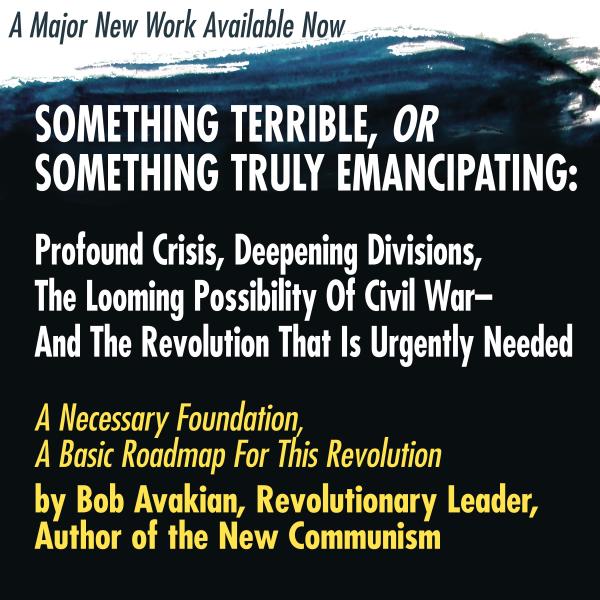
Something Terrible, Or Something Truly Emancipating...
As Bob Avakian says in a major work that came out earlier this year, "SOMETHING TERRIBLE, OR SOMETHING TRULY EMANCIPATING: Profound Crisis, Deepening Divisions, The Looming Possibility of Civil War—And The Revolution That Is Urgently Needed. A Necessary Foundation, A Basic Roadmap For This Revolution":
Many people—including someone like Martin Luther King—have argued that attempting to carry out a revolution to overthrow this system is suicidal, particularly for Black people in this country—when, in fact, Black people, and masses of other oppressed and exploited people, profoundly and desperately need this revolution. The reality is that such a revolution can succeed, but this is possible, particularly up against powerful ruling forces, like in this country, only in rare times and circumstances. And here is a very important truth: This is one of those rare times and circumstances.
